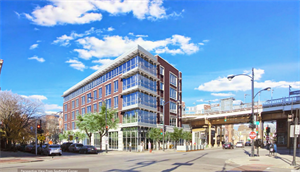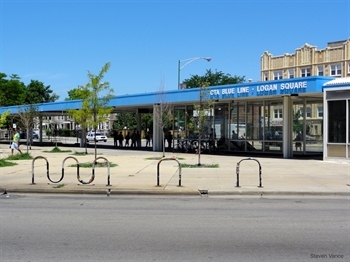
Metropolitan Planning Council
MPC's transit-oriented development agenda is a recipe for more robust growth in Chicago.
I don’t think many of my family members get what I do for a living. My cousin is a teacher, another cousin is a doctor, another’s in sales. I do policy and research. Conversations about work often end with a blank stare and a smile, or go something like this….
Uncle Bob: “Chrissy, you work for the City, right? Can you get me a parking permit?”
Me: “Well, Uncle Bob, I don’t work for the City Clerk, so can’t pick you up a parking permit. I do work with local governments though, on issues like transit and affordable housing.”
Uncle Bob: “Transit? Do you have any spare CTA passes?”
Me: [Face. Palm.]
The Metropolitan Planning Council’s (MPC) mission is to make the Chicago region a better place to live and work by partnering with businesses, communities and governments to address the area’s toughest planning and development challenges.
But what does that mean?
A typical day at MPC can range from drafting legislation for innovative transit funding, to pulling together business and government leaders for a discussion about the region’s water supply, to holding a community meeting to model a neighborhood housing development. One day is not like the next.
So in the spirit of showing the world why MPC matters (and having a better conversation with Uncle Bob), last year we began quantifying how all of MPC’s projects are helping to make the Chicago region the best place to live and work in the country. That means attaching real numbers that mean something to real people to our research, collaboration and policy implementation, which can often be squishy business.
Year one is coming to an end and I’m happy to report we’ve made progress—especially in giving people the opportunity to live closer to transit.
Growing around transit will grow Chicago
MPC’s mission is to make Chicagoland a better place to live and work. However, data shows the Chicago region grew by just 0.22 percent per year between 2010 and 2013, far outpaced by peer cities. More bizarre is that most places in the city—as distinct as Lincoln Park and Englewood—have lost population. Reversing this trend is critically important. More people will mean more home sales, construction jobs, local purchases and tax revenue to support retail, city services and infrastructure.

Centrum Partners
The Chicago transit-oriented development ordinance made this apartment building possible on a former empty lot next to the Paulina Brown Line station—people instead of concrete.
We know that people, especially the millennial generation, want more transportation options and often put off car ownership. So with one of the best transit systems in the country—thousands of miles of rail and bus lines and new bus rapid transit routes in the works—the Chicago metropolitan area’s public transportation network is our ticket to growth. Transit access is not only attractive to businesses and developers, but also connects residents to jobs, amenities and recreation.
Yet for decades, the region’s growth trended away from the transit system. This change drew people and jobs away from many walkable neighborhoods.
Why was that the case?
Though transit-oriented neighborhoods in the city of Chicago are in demand, zoning policies have limited the construction of new housing, even around transit stations. As a result, developers could not build places that allow people to live and work near transit—exactly what people want. This lack of desirable housing translated into population loss. For example, transit-rich Lincoln Park has lost 40 percent of its population since 1950, declining from 102,000 people to just 64,000 today. There’s just not enough available housing in desirable, transit-rich neighborhoods.
If Chicago wants to grow and grow sustainably, then zoning should reflect that goal and encourage more units near transit. MPC saw that Chicago wasn’t realizing the full potential of one of its greatest assets—transit. And we set a goal to fix it.
The recipe for making it happen
Our goal of giving 100,000 people the opportunity to live closer to transit is a mighty one. So MPC’s transit-oriented development initiative became an organization-wide priority. We knew there was significant support for one key part of the initiative, encouraging more investment and growth near transit in the City of Chicago. During his first term, Mayor Rahm Emanuel instituted transit-oriented zoning reform, allowing projects near rail stations to benefit from reduced parking requirements and increased density.
As a result, developments across the city added hundreds of housing units and new commercial spaces to neighborhoods that have lost population in recent years—without adding congestion or pollution. Some buildings could not have been built without the ordinance, as they took advantage of reduced parking requirements to free up space for other uses and ease construction costs.

Steve Vance
People want to live close to transit.
But the 2013 ordinance affected little of the city’s land area: Just 3.1 sq. mi. of land, or 1.8 percent of the city, qualified for reduced parking requirements. And an even smaller share—just 0.3 sq. mi., or 0.2 percent of the city—qualified for increased density.
The ingredients
MPC wanted to expand the land that qualifies for transit-oriented development zoning. To make that argument we began by analyzing current zoning regulations and financing tools to show how they significantly limit new construction in areas close to transit. We then conducted interviews with developers, community groups and city officials to evaluate what kinds of changes would be most effective in bringing additional population and jobs to areas near transit.
In summer of 2015, MPC unveiled Grow Chicago, a campaign to grow our city’s population by increasing the opportunity for housing and commercial development near public transportation. Our interactive website, which features a user-friendly calculator, allowed community groups, aldermen and developers to design an actual project and explore the benefits of development near transit, including local business sales, population and transit ridership growth, additional tax revenue and new jobs.
We presented the calculator and the benefits of building near transit at neighborhood meetings, aldermanic briefings and business lunches. We educated the public that additional density would be beneficial for their communities by helping local businesses and eliminating vacant land. We worked with a collaboration—comprised of community, financial, development, nonprofit and governmental organizations—to support an extension of the 2013 transit-oriented development ordinance.
The extended ordinance passed City Council in September. Over five years it will give an additional 50,000 people the opportunity to live near transit and lower their overall household costs because they’ll need to drive less.
How’d we get calculate number? According to the Chicago Metropolitan Agency for Planning, the city of Chicago is expected to grow by 400,000 people through 2040, of which a significant portion—about 75 percent—could be located near transit. That translates to about 10,000 people a year for the next five years. And the resulting development will create jobs and leverage private investment.
Some buildings could not have been built without the ordinance, as they took advantage of reduced parking requirements to free up space for other uses and ease construction costs.
We’re not finished. In 2016 we’ll work to establish a dedicated pool of low-interest loans in Chicago that would encourage the development of affordable housing near transit in high-income neighborhoods and help attract new retail and community amenities to other parts of the city.
MPC’s five-year goals help us wrap our work up in a bow. I’m personally grateful for that, since now when I talk to my Uncle Bob, he’ll get that I don’t pass out free parking passes.